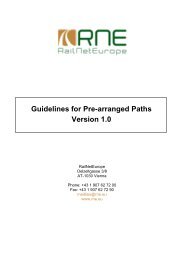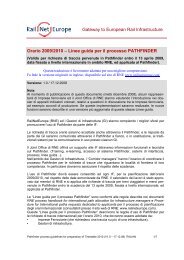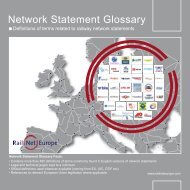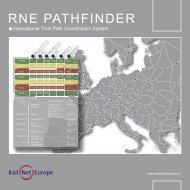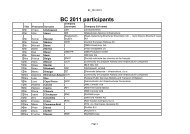Pathfinder Orange Book for Version 2.2.4 - RNE
Pathfinder Orange Book for Version 2.2.4 - RNE
Pathfinder Orange Book for Version 2.2.4 - RNE
You also want an ePaper? Increase the reach of your titles
YUMPU automatically turns print PDFs into web optimized ePapers that Google loves.
<strong>Pathfinder</strong> <strong>Orange</strong> <strong>Book</strong> <strong>Version</strong> <strong>2.2.4</strong>3 Catalogue paths3.1 SummaryCatalogue paths can be saved, retrieved and requested within <strong>Pathfinder</strong>. To do this, a pathcatalogue has been implemented in <strong>Pathfinder</strong>. This path catalogue contains the catalogue pathscreated by the IM’s <strong>for</strong> the RU’s (offers made by the IM’s to the RU’s).An element of <strong>Pathfinder</strong> <strong>Version</strong> 1.5 is to be able to search <strong>for</strong> catalogue paths using various searchparameters. No function is being developed to search <strong>for</strong> catalogue paths with a view to theautomatic or semi-automatic construction or linking of paths. However, any number of cataloguepaths can be searched <strong>for</strong> and linked to <strong>for</strong>m a corridor.3.2 Definition of catalogue pathsCatalogue paths are paths which are constructed and offered by the infrastructure manager (IM)using various parameters and not specifically requested by any RU. A catalogue path may be basedon the IM’s’ experience or on the RU’s’ requirements or it may have been “pre-produced” in advanceaccording to the RU’s’ specification. Depending on the time at which they are produced within theprocess of approving the annual timetable, a distinction is made between two types of cataloguepaths.According to International Timetable Process, Catalogue Paths do not belong to RU´s at any stageof the process and are proposed by the IM´s to facilitated work <strong>for</strong> RZ´s and IM´s.3.2.1 Differentiation by availability3.2.1.1 Static catalogue pathsAt the start of the approval process between the RU’s and the IM’s, (X-14 to x-8) the IM’s canproduce static catalogue paths. Static catalogue paths represent theoretically usable paths with noindication of their actual availability. Static catalogue paths can be useful to the RU’s in simplifyingpath enquiries.3.2.1.2 Dynamic catalogue pathsOnce the annual timetable has come into effect, the catalogue paths that are still available can bestored in <strong>Pathfinder</strong> as capacity <strong>for</strong> use during the year. The calendar of dates in service can beused to show <strong>for</strong> each of these catalogue paths on which specific days they are still available.Differentiation by availability there<strong>for</strong>e depends essentially on the time at which a catalogue path iscreated in <strong>Pathfinder</strong>. Be<strong>for</strong>e the time when the paths are allocated by the IM’s, the availability ofthe catalogue paths is generally not updated. Catalogue paths are then “sample paths” <strong>for</strong> theRU’s. After the path allocation process (ca. X-6) the “dynamic” catalogue paths represent capacitythat is still available but has already been planned <strong>for</strong>.Both types of catalogue paths are handled and implemented in the same way.Ordering dateTimetable changestatic catalogue paths as"sample paths" <strong>for</strong> use inordering by the RUs, withno updating of theiravailability (days ofcirculation)dynamic catalogue pathsas planned capacity.Availability demonstratedin terms of days ofcirculationX-5 towards timetable changeDecember 2010 Page 30 of 133



